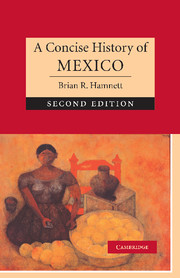Book contents
- Frontmatter
- Contents
- List of illustrations
- Chronology
- Preface to the second edition
- Preface to the first edition
- 1 Mexico in perspective
- 2 The pre-Columbian era
- 3 The European incursion, 1519–1620
- 4 New Spain, 1620–1770: Spanish colonialism and American society
- 5 Destabilisation and fragmentation, 1770–1867
- 6 Reconstruction, 1867–1940
- 7 The monopoly party, 1940–2000
- 8 The Fox administration, 2000–2006
- 9 Cultural developments since Independence
- Final comments
- Bibliography
- Index
- Titles in the series
Final comments
Published online by Cambridge University Press: 05 June 2014
- Frontmatter
- Contents
- List of illustrations
- Chronology
- Preface to the second edition
- Preface to the first edition
- 1 Mexico in perspective
- 2 The pre-Columbian era
- 3 The European incursion, 1519–1620
- 4 New Spain, 1620–1770: Spanish colonialism and American society
- 5 Destabilisation and fragmentation, 1770–1867
- 6 Reconstruction, 1867–1940
- 7 The monopoly party, 1940–2000
- 8 The Fox administration, 2000–2006
- 9 Cultural developments since Independence
- Final comments
- Bibliography
- Index
- Titles in the series
Summary
Two periods in the nineteenth century explained much of twentieth-century Mexico's characteristics. In the first place, the period 1836–67 altered the balance of power on the North American sub-continent in favour of the United States and against Mexico. The shock of military defeat, invasion and territorial loss in the war of 1846–48 ensured that relations with the United States would be the predominant issue in foreign relations thereafter. However, this preoccupation with the powerful, imperial neighbour has tended to obscure the supremely important Mexican success in repelling the French Intervention of 1862–67 and preventing the imposition of a European neo-colonial tutelage. The republican victory of 1867 enabled the continuation of the Liberal Reform programme, the essence of which was the solidification of a constitutional system and the secularisation of society.
The second defining period is 1884–1911, when Díaz consolidated his personal rule. Controversy over how to interpret this period still continues. The constitutional experiment of 1855–76 – with all its imperfections – was, in effect, abandoned after 1884. A regime, which originated in a military rebellion in 1876, proceeded to weaken rather than reform or strengthen the institutions established in accordance with the Federal Constitution of 1857.
- Type
- Chapter
- Information
- A Concise History of Mexico , pp. 341 - 344Publisher: Cambridge University PressPrint publication year: 2006

